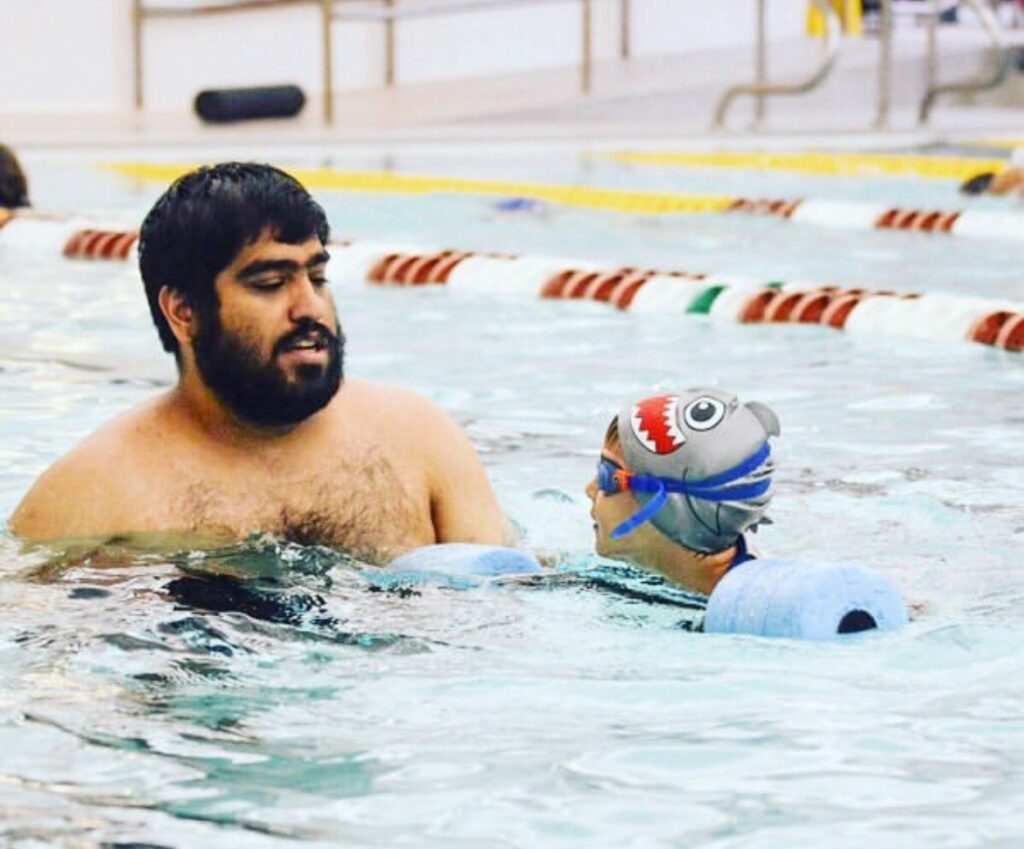May 23, 2024
Dive into Safety: Essential Tips for National Water Safety Month

Our morning pool deck manager Michael Chouieri, seen here, teaches a child swimming and water safety in the Zesiger Center teaching pool
By Demetris Chambliss, full-time swim instructor
What is National Water Safety Month? Every May, we celebrate National Water Safety Month, an annual awareness campaign coordinated by the Pool & Hot Tub Alliance with support from the American Red Cross, National Drowning Prevention Alliance, National Recreation and Park Association, and World Waterpark Association. Throughout the month, aquatic programs and organizations across the country host various events and initiatives to promote water safety.
Why is Water Safety Important? Water safety isn’t just important—it’s critical. According to the CDC, drowning rates have reached an all-time high over the past four years, with over 4,500 drowning fatalities annually. In Massachusetts alone, there were 69 fatal drowning incidents in 2021, with 11 victims aged 17 and younger, and 58 victims aged 18 and older (mass.gov). For toddlers aged 1-4, unintentionally injuries are the leading cause of death, drownings having the highest mortality rates. Given these statistics, water safety is, and has always been, my top priority in every aquatic setting I work in, especially in swim instruction. While my students and coworkers may know me as a swim instructor or a coach, my primary role is teaching water safety for I am a certified American Red Cross Water Safety Instructor. Meaning before we even consider stroke techniques and aquatic sports, my first responsibility is to teach my students how to be safe in and around water.
5 ways to Stay Safe In and Around Water
1. Take Swim Lessons: If you don’t know how to swim, it’s never too late to learn! Fun fact: my oldest student was 95 years old. According to the CDC, almost 40 million adults in the United States do not know how to swim, and over half have never taken a swimming lesson. Swim lessons can literally be the difference between life and death. The American Red Cross recommends starting lessons as early as six months so infants can become comfortable and better acclimated to water.
2. Never Swim Alone: Always try to swim with a buddy. If you’re in a public setting, make sure a lifeguard is on duty before entering the water. Follow the rules of the site—the rule are there to keep you safe. In private settings, ensure there is an adult present for youth and that you have the appropriate gear for your swimming skills. For weaker swimmers, use a US Coast Guard-approved life jacket and have an adult physically in the water for support. Avoid inflatable flotation devices as they can pop and create a dangerous situation.
3. Avoid Swimming Under the Influence: Never go into large bodies of water if you are under the influence of drugs, alcohol, or even prescription or over-the-counter medications that affect your alertness. Anything that impairs your judgment or sense of awareness can be extremely dangerous when swimming.
4. Check Water Safety: Before entering any body of water, ensure it is safe. This includes checking for signs of pollution, strong currents, or any other hazards. Always be aware of the local conditions and any posted warnings.
5. CPR Certification: It’s wise to have at least one or two people in your group who are CPR certified. In case of an emergency, having someone who can perform CPR can make a critical difference. It’s a lifesaving skill that everyone should consider learning. The American Heart Association, the American Red Cross, the American Safety Training Institute, and the Health and Safety Institute are four trusted organizations that offer basic CPR classes across the country!
By following these tips, you can enjoy the water safely and prevent accidents. Remember, water safety is all about being prepared and aware of your surroundings.
Happy National Water Safety Month!
Here are some links to learn more about water safety tips and statistics!

Comments
There aren't currently any comments on this blog entry.